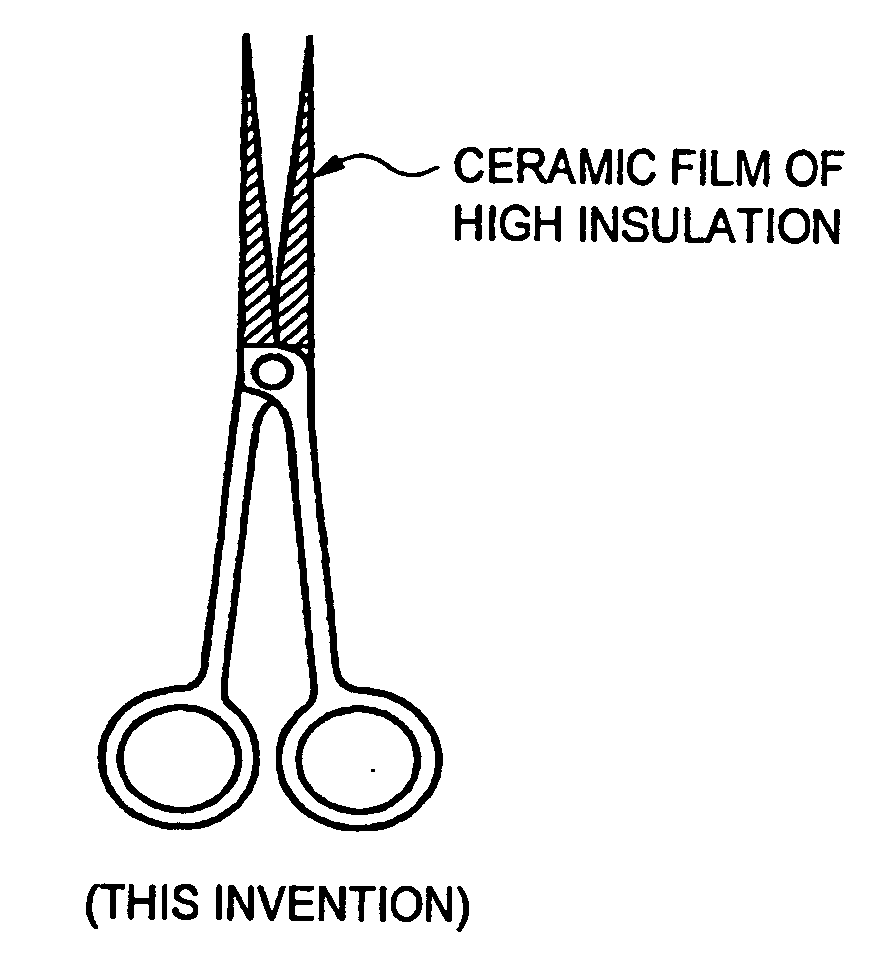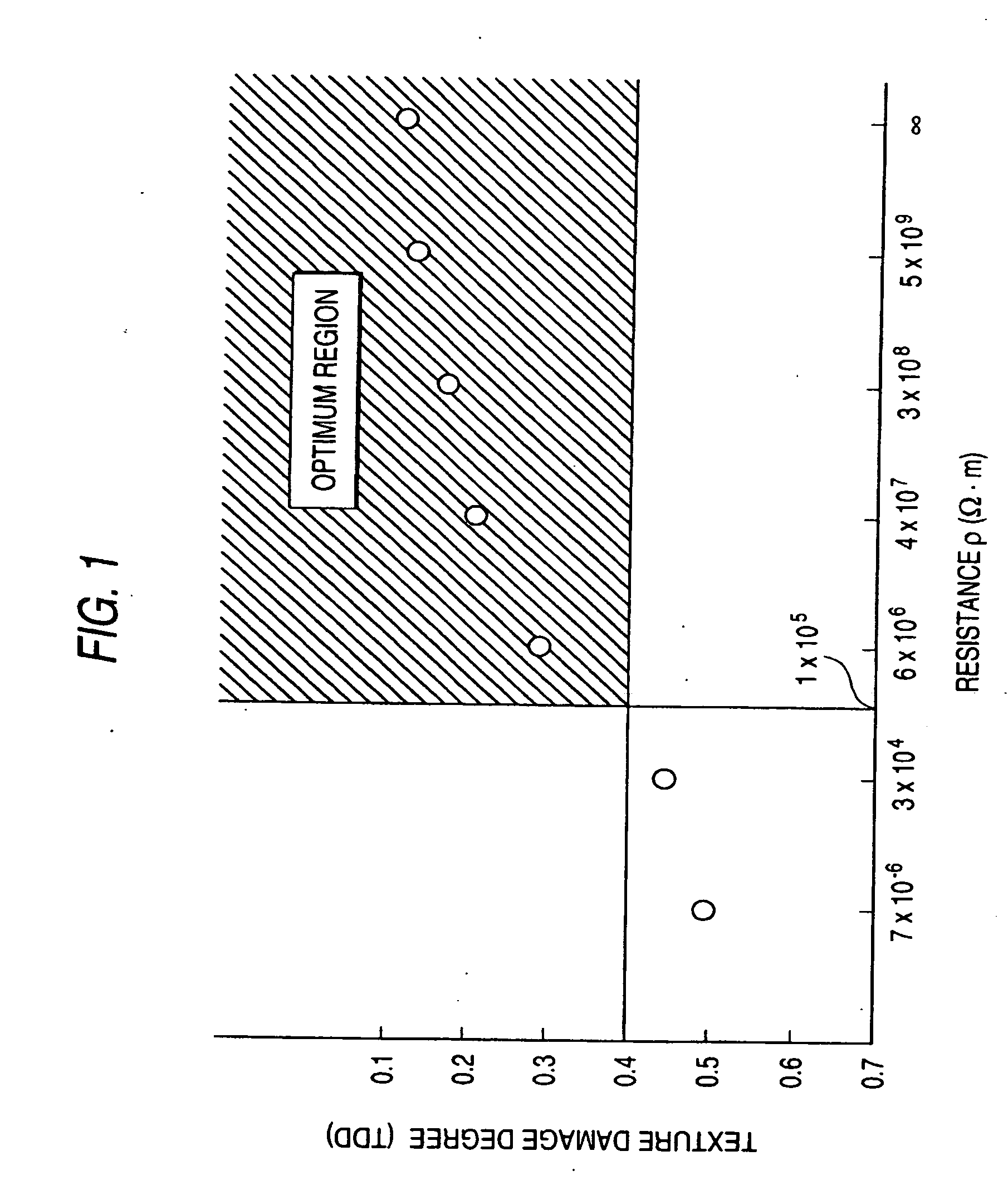Ceramic-coated medical and biopsy appliances and fabrication method therefore
a technology of ceramic film and biopsy tube, which is applied in the field of ceramic film medical or biopsy tube, can solve the problems of high risk of ceramic film peeling, unfavorable effects, and tissue tear-off, and achieve the intended obj
- Summary
- Abstract
- Description
- Claims
- Application Information
AI Technical Summary
Benefits of technology
Problems solved by technology
Method used
Image
Examples
example 1
[0175] A ferritic stainless steel material, containing C: 0.039 mass %, Si: 0.25 mass %, Mn: 0.12 mass %, P: 0.008 mass %, S: 0.012 mass %, and Cr: 18.9 mass % with the remainder being Fe and unavoidable impurities, was subjected to continuous casting process, followed by hot rolling, cold rolling and bright annealing, and then high-precision worked into biopsy forceps, forceps, surgical scissors and a surgical knife.
[0176] Subsequently, the medical appliances were supersonically cleaned and subjected to the magnetron sputtering process illustrated in FIG. 5 for formation of various ceramic films on the individual portions shown in FIGS. 2A to 4A. Specifically, the SiNx film was formed on the biopsy forceps, the SiO2 film was formed on the forceps, a BN film was formed on the surgical scissors, and an Al2O3 film was formed on the surgical knife. For comparison purpose, a TiN film was formed on the biopsy forceps. All the coating films had a thickness of about 1 μm. Thickness measur...
example 2
[0180] A ferritic stainless steel material, containing in mass percentage C: 0.033%, Si: 0.20%, Mn: 0.15%, P: 0.008%, S: 0.008%, and Cr: 17.7% with the remainder being Fe and unavoidable impurities, was subjected to continuous casting process, followed by hot rolling, cold rolling and bright annealing, and then high-precision worked into a puncture needle (outside diameter: 2.0 mm, length: 170 mm), biopsy forceps, forceps, surgical scissors and a surgical knife.
[0181] Subsequently, the medical appliances were supersonically cleaned and subjected to the magnetron sputtering process illustrated in FIG. 5 (with the RF device also used in some step) for formation of various ceramic films listed in Table 2 in the high-plasma atmosphere. In the coating process, the former stage was carried out in the normal coating atmosphere, whereas the latter stage (surface coating portion: 0.5 μm in thickness) was carried out with oxygen gas introduced in the atmosphere in different amounts. All the ...
example 3
[0185] A ferritic stainless steel material (a) containing C: 0.03 mass %, Si: 0.2 mass %, Mn: 0.15 mass %, P: 0.010 mass %, S: 0.010 mass %, and Cr: 18.8 mass % with the remainder being Fe and unavoidable impurities; and an austenite stainless steel material (b) containing C: 0.05 mass %, Si: 0.3 mass %, Mn: 0.20 mass %, P:0.012 mass %, S: 0.011 mass %, Cr: 19.1 mass %, Ni: 9.1 mass % and Mo: 0.25 mass % with the remainder being Fe and unavoidable impurities were each subjected to continuous casting process, followed by hot rolling, cold rolling and bright annealing, and then high-precision worked into a contrast medium needle having an outside diameter of 0.8 mm and a length of 200 mm. After supersonically cleaned, the contrast medium needles were set in the magnetron sputtering system shown in FIG. 5 for SiNx film formation in the high plasma atmosphere.
[0186] The magnetron sputtering process formed the SiNx ceramic film in a thickness of 0.8 μm under the conditions of Ar: 100 sc...
PUM
 Login to View More
Login to View More Abstract
Description
Claims
Application Information
 Login to View More
Login to View More - R&D
- Intellectual Property
- Life Sciences
- Materials
- Tech Scout
- Unparalleled Data Quality
- Higher Quality Content
- 60% Fewer Hallucinations
Browse by: Latest US Patents, China's latest patents, Technical Efficacy Thesaurus, Application Domain, Technology Topic, Popular Technical Reports.
© 2025 PatSnap. All rights reserved.Legal|Privacy policy|Modern Slavery Act Transparency Statement|Sitemap|About US| Contact US: help@patsnap.com



